O Little Town of Bethlehem
PeriBlog XI: Does this Palestinian town live up to its show tunes?
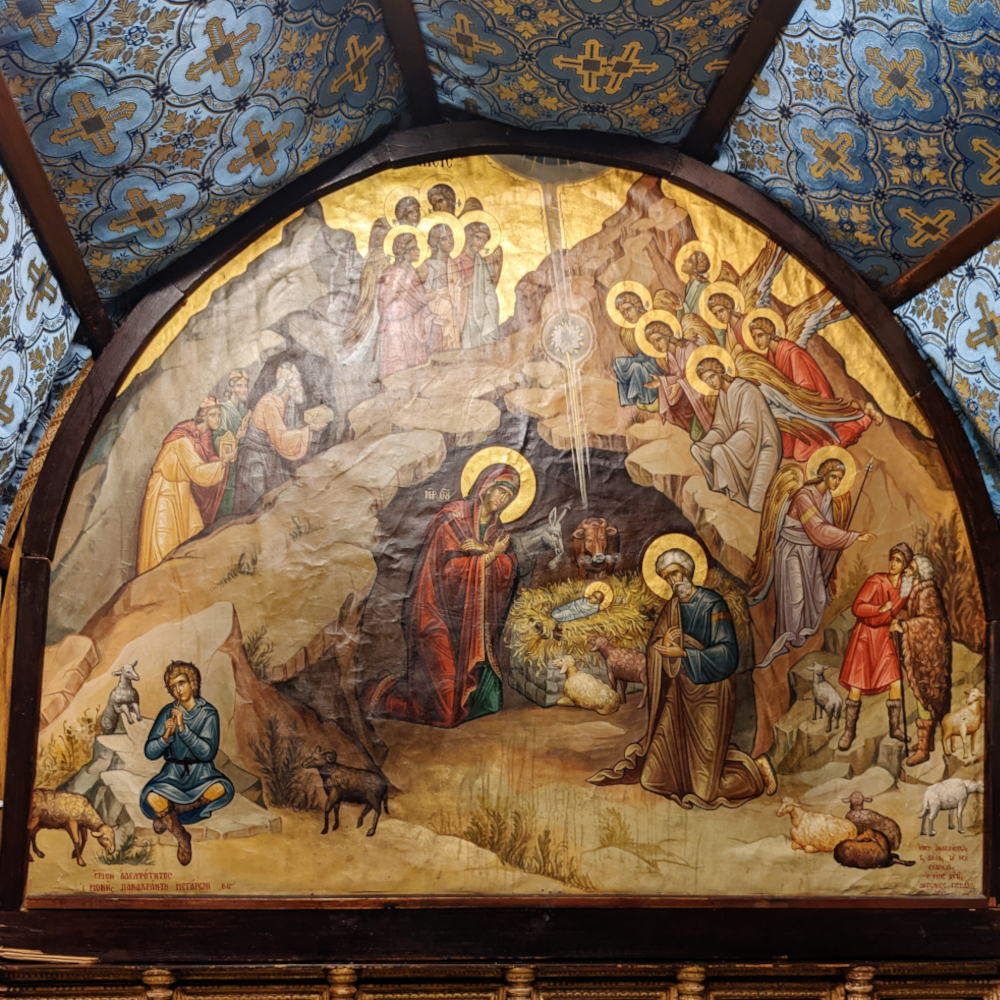
A traditional rendition of Christ’s birth
O Little town of Bethlehem / How still we see thee lie….
It’s a saccharine little Christmas carol, lyrics written by an American clergyman named Phillip Brooks in 1868. Set to two musical arrangements—the American and the British—it serves as the background track for countless nativity displays.
If you are like me, you grew up listening to this Christmas carol. Subjected to annual displays of creches and mangers, cute donkeys and solemn shepherds, we formulated a mental image of how that pivotal scene, more than 2,000 years ago, must have appeared.
But does the actual place resemble the idyllic scene portrayed in the Christmas carols? This question demanded investigation.

The ubiquitous Service
A Service—pronounced “Ser-veez”—is the easiest way to travel from Ramallah to Bethlehem. The Service is a cross between a bus and a private taxi. Seating seven passengers, Services depart from central Ramallah for points across the region. Unlike a bus, they keep no fixed schedule. Passengers arrive, take a seat, and when the van is full, the Service departs.
Pro tip: If you are in a hurry, you can pay the fare for the empty seats and the driver will leave immediately.
In addition to their other charms, a Service is relatively inexpensive; a one way trip from Ramallah to Bethlehem costs 21 New Israeli Shekels—about $6.00 USD. Quite a bargain.
We waited five minutes and then a man in his early twenties climbed into the last empty seat beside me. We were ready to go. Our Service rolled out of Ramallah and then, oddly in my opinion, we abandoned the main road and started a rat run through the side streets, dodging and weaving through the city’s industrial outskirts.
Our driver pulled up in front of a warehouse that wore a Mercedes logo. Two men hustled a wooden crate out of the building’s murky depths and stashed it in the back of the Service.
Since this was my first time aboard a Service, I have no yardstick to judge what is customary. This little stop did seem odd. Was our driver running a little side hustle, an off-the-books freight service between Ramallah and Bethlehem?
It was a mystery.
Twenty-one kilometers—about 13 miles—separates Ramallah and Bethlehem. Of course that is as the White-tufted Israeli Buzzard flies. Jerusalem squats on the line between the two cities, and Palestinian transports must detour around the city.
It took much longer than expected—a ninety minute trip. I had ample time to stare out the window at the bleak scenery. Conditioned by the lyrics of Christmas carols, I expected lush, verdant fields and ample forests. Jesus was born in farm country, a quiet stable near a lovely wooden inn. I imagined a green, leafy bower, surrounded by rolling fields and crops ready for the harvest. There would be donkeys and oxen pulling plows in the distance, cattle lowing, brooks babbling.
How great the distance between the imagined and the real. Bethlehem sits on the northern edge of the Negev desert. It is a hill-top town, perched on a stark, buff-colored outcrop. Vegetation ranges from sparse to non-existent. Dogged clumps of thorns stand like gray bones, drained of both life and chlorophyll. There is no green at this time of year—just sunburned earth and exposed seams of rock. It is a harsh, dry, gritty landscape, bleached and battered by the elements.
Now I understand why the Magi arrived on camels.
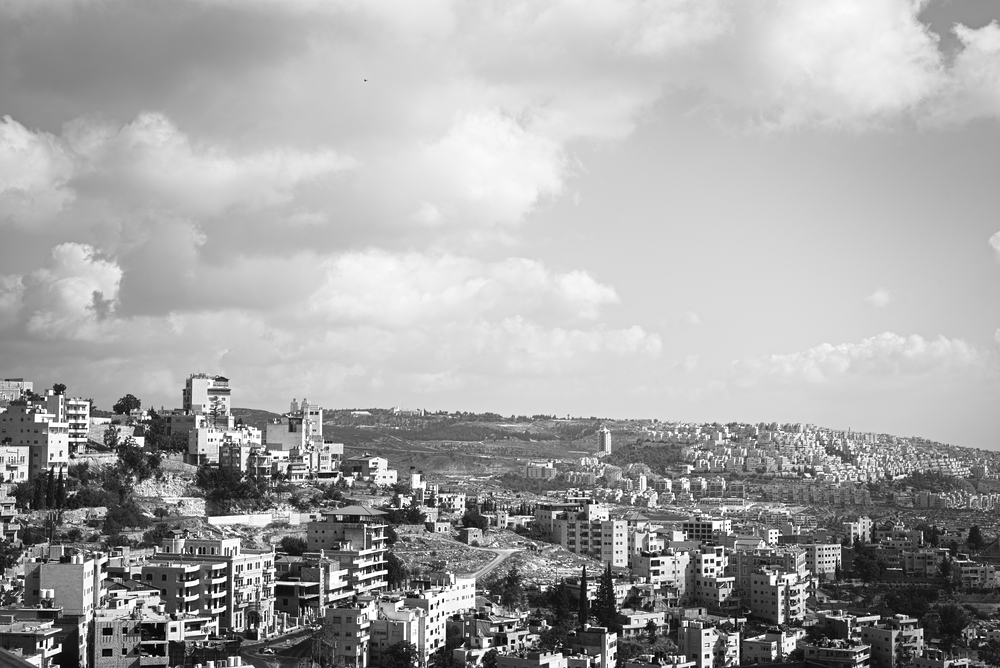
Bethlehem spreads across an arid hillside
At the base of the hill, we slid off the road into a spot before a Mercedes dealership. Two mechanics dashed out and unloaded our cargo. On we drove. I hope it was a profitable transaction.
We reached our lodgings, and after a short rest to gather energy, set off for our first attraction, the Church of the Holy Nativity. The church stands on the eastern end of Manger Square, Bethlehem’s spiritual and geographical center.
Ida Pfeiffer, a nineteenth century German visitor, found her first experience of Bethlehem disagreeable. She disliked the crowds of begging children: “Nowhere have I been pestered with beggar children as in this town. Hardly has the stranger reached the convent gates before these urchins are seen approaching from all quarters. One rushes forward to hold the horse, while a second grasps the stirrup; a third and fourth present their arm to help you dismount; and in the end the whole swarm unanimously stretch forth their hands for ‘backsheesh.’ In cases like these it is quite necessary to come furnished with either a multiplicity of small coins or with a riding whip, to be delivered in one way or another from the horrible importunity of the diminutive mob.”
You will be happy to know that begging children no longer swarm visitors. The modern tourist must run a variety of tout gauntlets. There is the taxi tout gauntlet—“Taxi, mister? Go see the wall? Go to Mar Saba? Shepherds’ Field?” and the tour tout gauntlet—“You need guide for church?”
“Come into my shop,” call the souvenir shop touts. “Hand-carved olive wood. Special price for you, forty percent discount.”
And so it goes. I had grown unused to the aggressive attention. I can walk the streets of Ramallah without the "horrible importunity," but in Bethlehem, tourists and touts have tangoed for centuries.
Tradition tells us that the Emperor Constantine’s mother, Helena, "discovered" and lent her imprimatur to the cave of the nativity, the spot where Jesus entered the world. Helena, you will recall, was also responsible for discovering the one true cross and identifying the tomb in which Jesus lay before his resurrection (see PeriBlog VII: The Church of the Holy Sepulchre for details).
She is also credited with establishing this church in Bethlehem, and while some historians and archaeologists might question the veracity of the tradition, portions of this church do date back to the early fourth century.
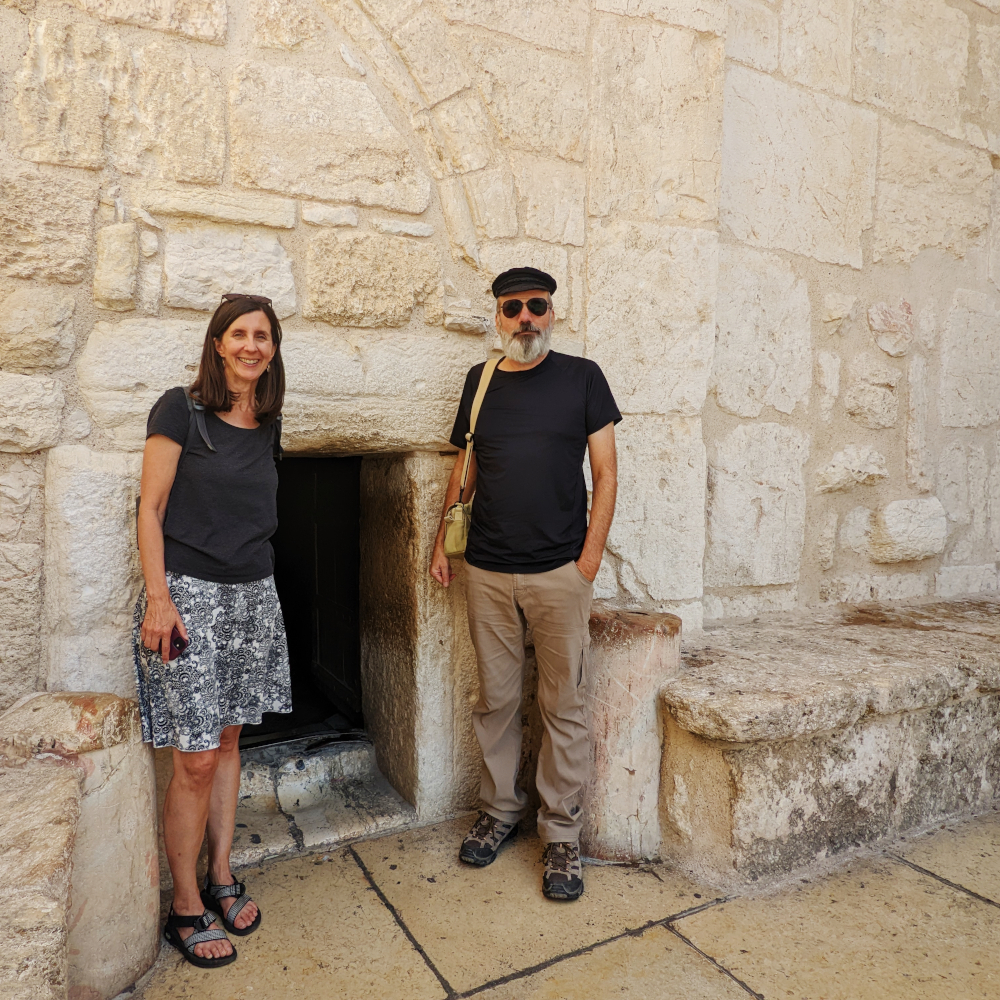
Posing before the door of humility
One enters the church through the “door of humility.” It takes its name from the fact that all but the shortest must bow low to scrape beneath the lintel while entering the church. Although this act has spiritual implications, the awkward design conceals a deeper practicality.
A much larger door once penetrated the wall. The discerning eye easily perceives the outline of this earlier portal in the stone that surrounds the smaller door of humility. The crusaders blocked up the original doorway for defensive reasons: a tiny door ensured that the church’s enemies would have to dismount from their war horses and assume an awkward shuffle to enter the building.
I crouched like an ungainly Blue Heron—folded limbs and bent legs—and waddled into the church.
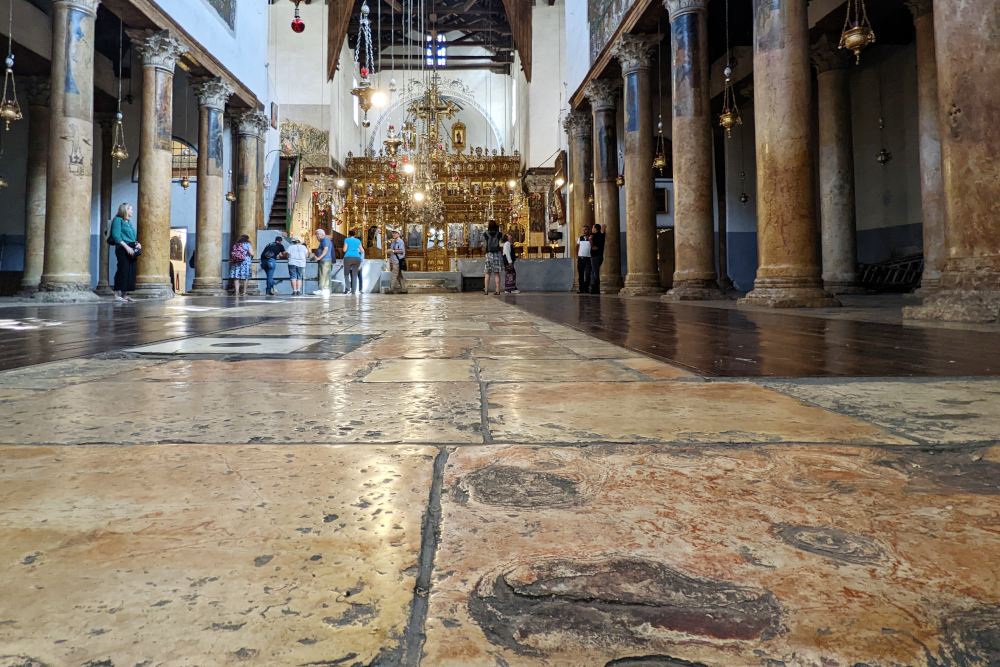
Nave, Church of the Nativity, Bethlehem
Christianity’s earliest churches drew their architectural inspiration from Roman basilicas—administrative buildings where government officials dealt with state business. The Church of the Nativity embraces this floor plan. Two double rows of columns flank a central aisle. These columns are the most prominent relics of the original fourth century church. Made of polished marble, they support the wood beams of the roof. The section of the columns that are within an arm’s reach carry the scars of modern graffiti. Higher, near the top of several pillars, are frescoes painted during the Crusader’s occupation of the city.
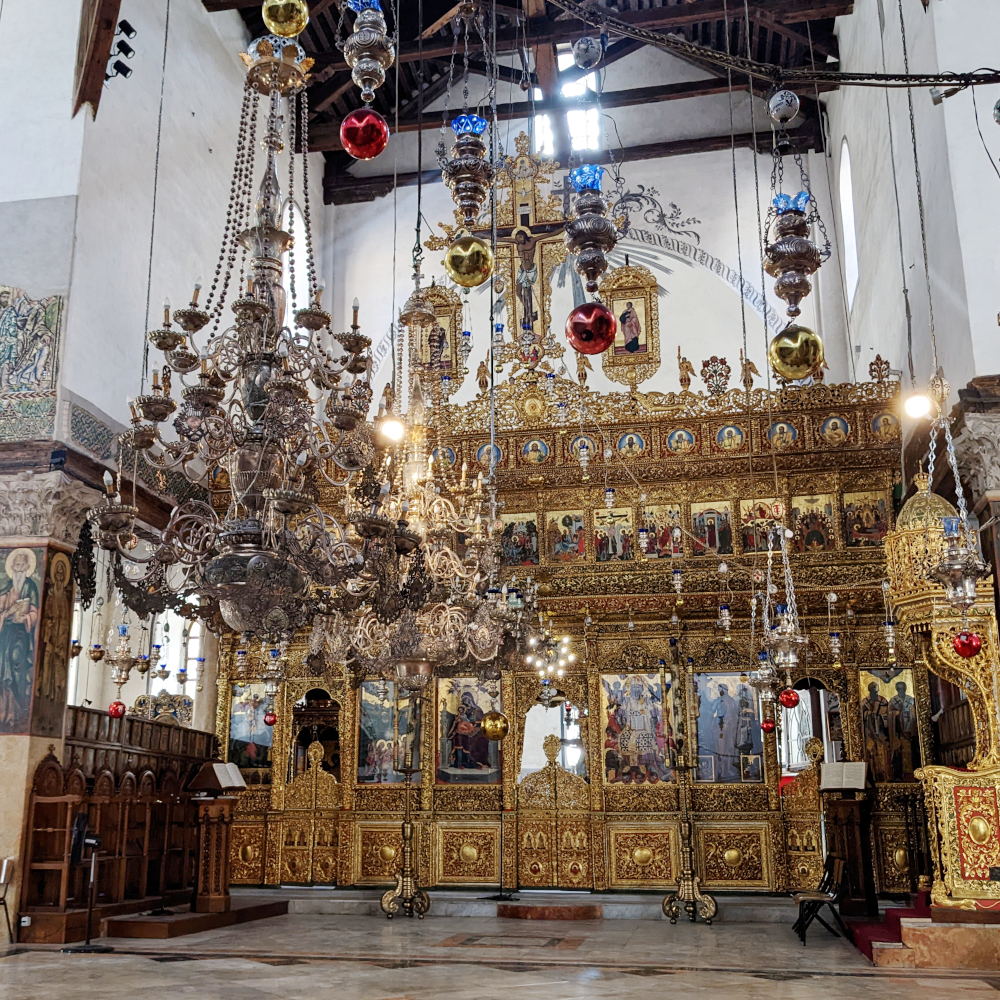
High altar, Church of the Nativity, Bethlehem
The high altar stands at the eastern end of the church, built over the cave of the nativity. Visitors wind around the right side of the altar, under a second doorway, and, assuming that several tour groups aren’t clogging the way, enter the holy of holies. When the tour buses are unloading, a visitor can wait an hour or more for a chance to visit the cave. I can’t imagine what it would be like at Christmas or Easter.
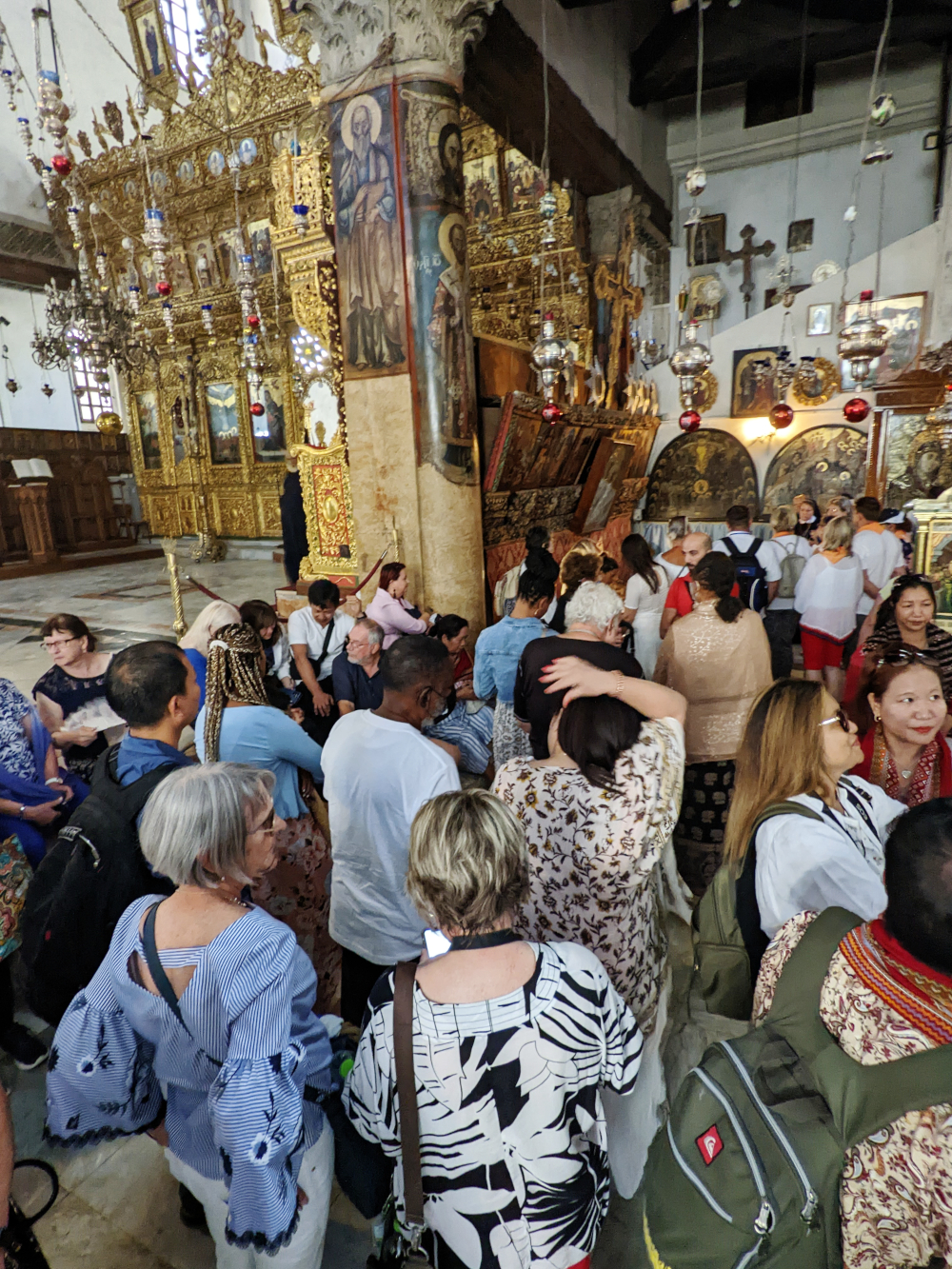
Tour traffic jam outside the cave of the Nativity
A flight of steps descends beneath the altar, into the cave that may have served as Jesus’ birthplace.
We have hit the church at an optimal hour: the building is nearly empty and we pass down the marble staircase without a wait.
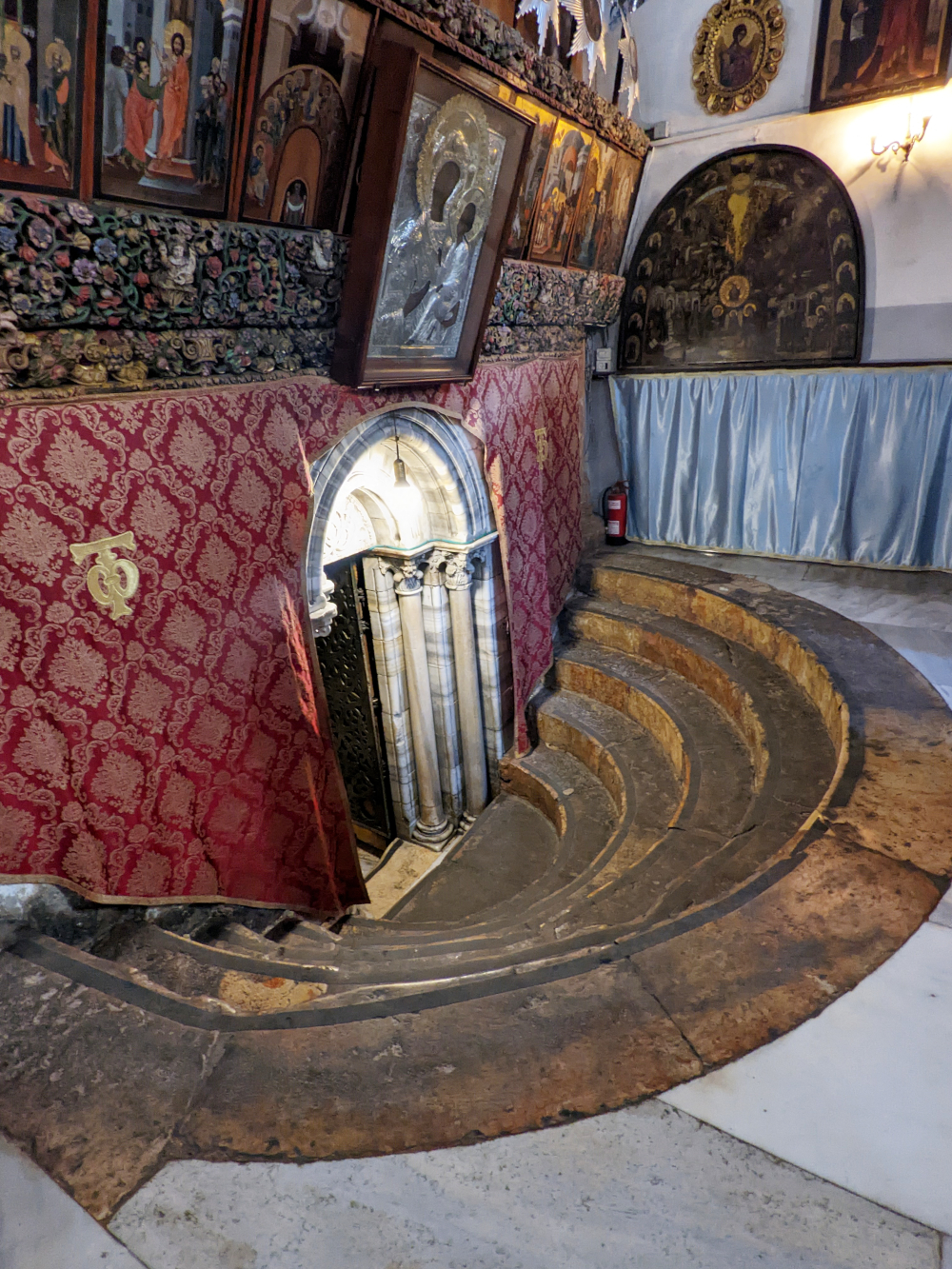
A flight of steps descends beneath the high altar
The center of attention at the bottom of the steps is a small altar built over a fourteen point silver star. Etched into the star’s metal are the words: “Hic de Virgin Maria Jesus Christus Natus Est-Here Jesus Christ was born from the Virgin Mary.”
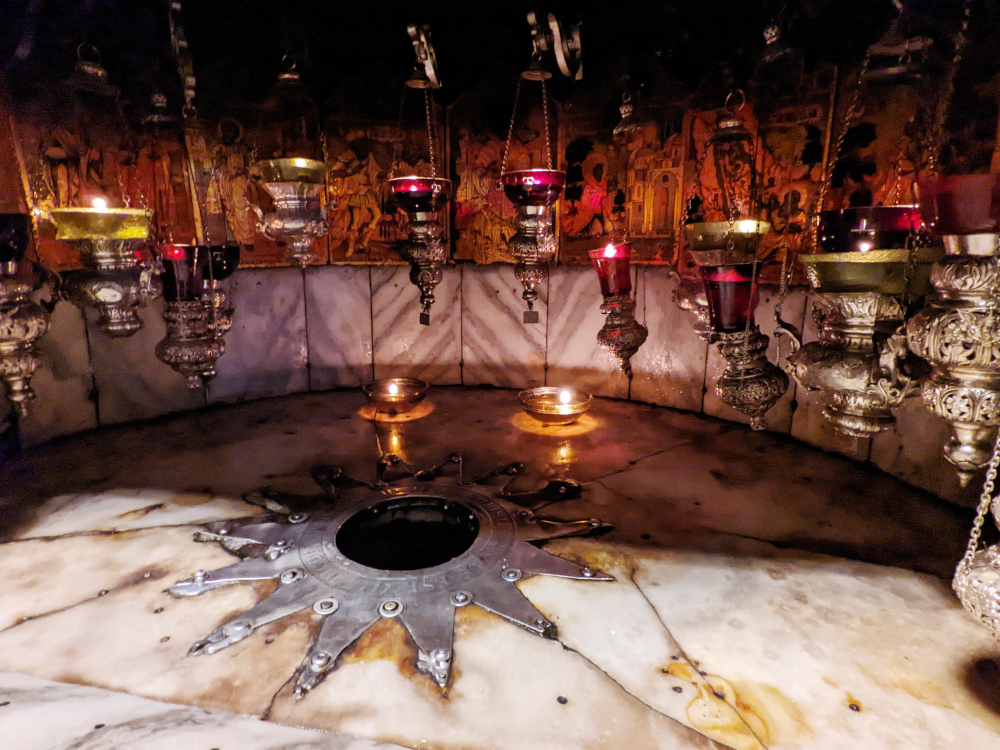
A fourteen-pointed silver star marks the spot
Once again I find myself straddling the chasm between my vocation (historian) and my faith. Tradition asserts that the silver star marks the spot, but tradition is a weak evidentiary category. Was Jesus really born here?
I don’t know. The most honest thing I am prepared to assert is that from at least the fourth century, people have believed this was Christ’s birth place. The consensus of centuries commands my respect. Without lapsing into mysticism, one could say that the prayers of millions of pilgrims have sanctified this spot, creating a spiritual nexus.
Turning one hundred and eighty degrees, one finds the holy creche, the spot where Mary lay baby Jesus in his swaddling clothes.
The walls of the cave are overlaid with thick, shellacked wall hangings. Small holes pierce the cloth, presumably allowing the faithful an opportunity to touch the holy walls, while simultaneously denying the less pious a chance to pry off a piece of the cave for their private collection.
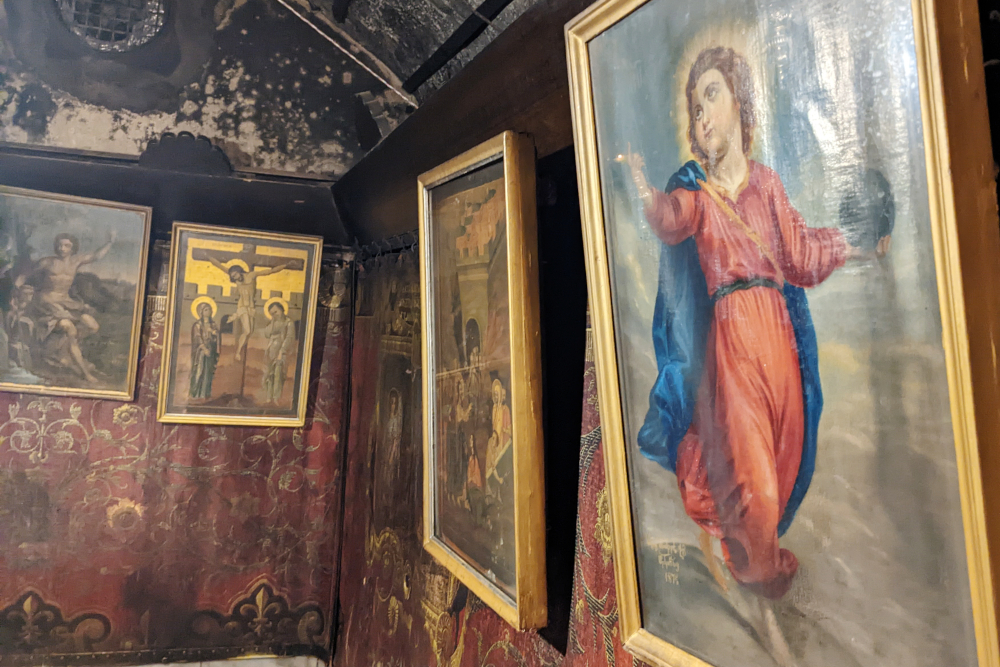
Paintings and heavy wall hangings line the cave
Aggressive uniformed guards patrol the upper and lower levels of the church. They shush loud tour groups, keep the faithful moving, and quell troublemakers. Overseeing predominantly Christian crowds, you might expect no trouble, but the need for guards suggests a different reality.
Here’s something else that we found unusual: in contrast with Italian churches, the Church of the Nativity is rather spare and simple. The altar is covered with art, gold leaf, and exotic oil lamps, but the walls lack ornamentation—no lush paintings by Caravaggio or Titian to divert one’s attention from the main attraction.
Protestants should approve. This is primitive Christianity, spare in decoration, stripped of worldly excess. Not only is the Church unadorned, but it is relatively small. Compare it to Rome’s St Peter’s Basilica, or St. Paul’s Outside the Walls. Jesus’ two leading apostles enjoy massive structures: you could easily slip the Church of the Nativity and the Church of the Holy Sepulchre into these buildings with plenty of room to spare.
The humble carpenter from Nazareth has a comparatively humble church. It is, in every way, a suitable monument to his birth.
If you are enjoying this series, why not subscribe to Richard's monthly newsletter, What's New in Old News? The Peripatetic Historian is on the road, roaming the world and compiling fresh adventures. Don't miss out. Click here to join the legions of above-average readers who have already subscribed.